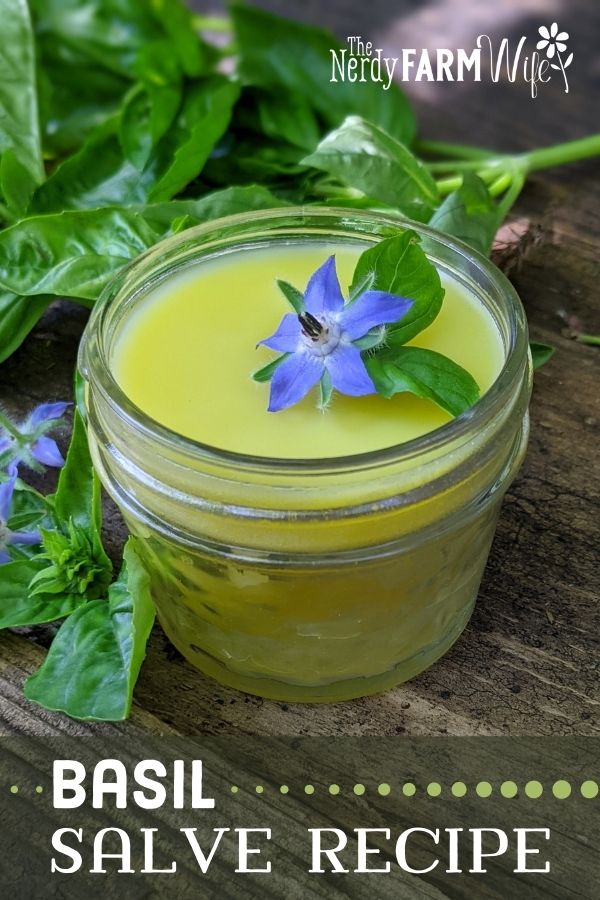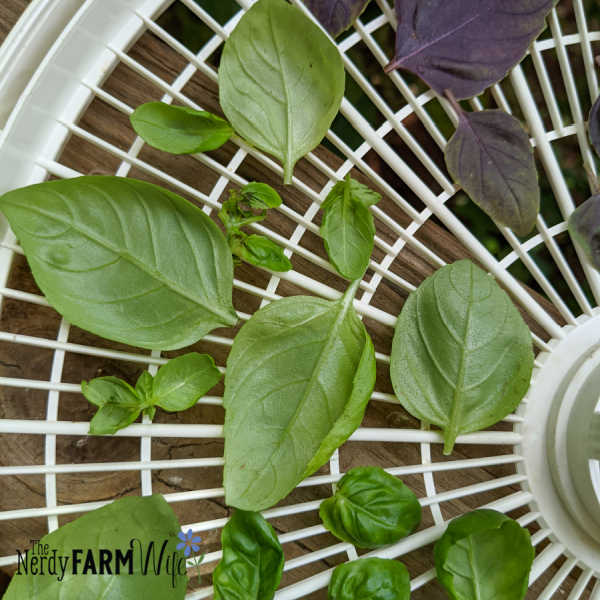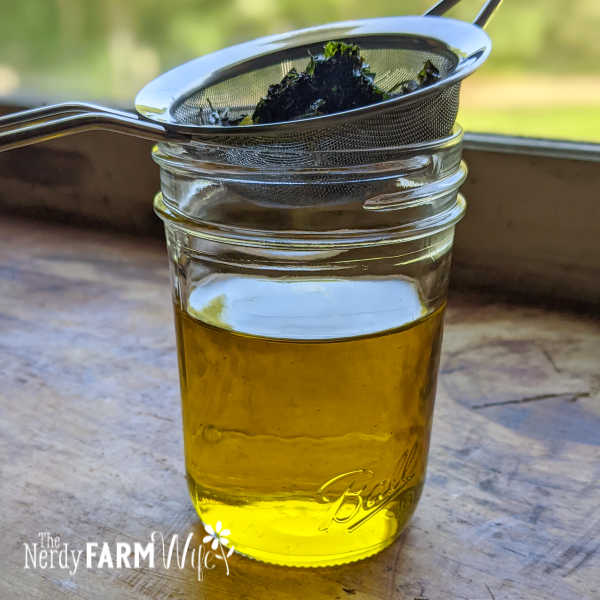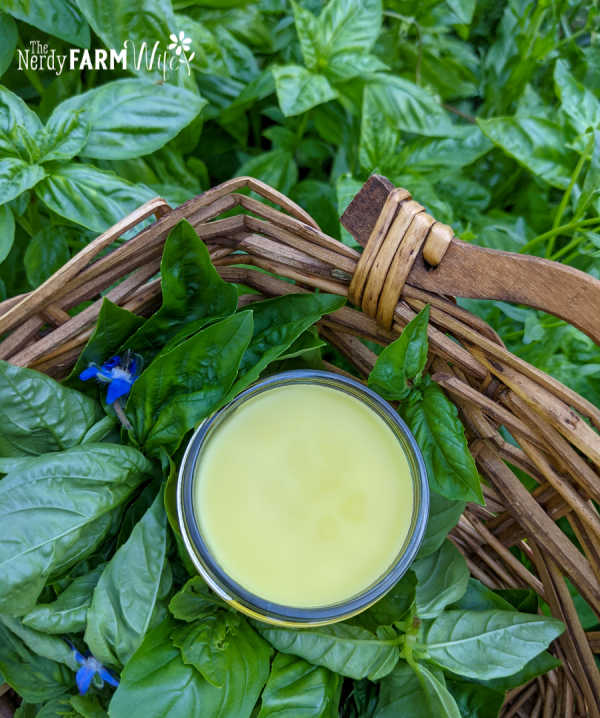How to Make Basil Salve (3 recipes)
Learn how to make helpful herbal salves using fresh basil from your garden!
While basil (Ocimum basilicum), also called sweet basil, or garden basil, is more commonly used for food purposes, it also contains healthful components used for digestion and respiratory issues.
Basil is also loaded with anti-inflammatory properties, making it useful for topical skin care products such as these salve recipes!
(Related: You may also enjoy my recipe for Basil Anti-Aging Skin Cream.)
In this article, you’ll learn about three basil salve ideas:
- Basil First Aid Salve – for minor scrapes, scratches & insect bites
- Basil Headache Salve – for cooling relief of head pain
- Basil Aches & Pains Salve – for general joint & muscle pain
Before we can make the salve, we first need to make the infused oil!
Some links on this site are affiliate links. I may earn a commission for purchases made.
How to Make the Infused Oil
By steeping an herb in oil, we can extract its beneficial properties for our use in salves, balms, and other products. We’re using newly dried plant material in this recipe, since fresh plants are more likely to spoil when mixed into oil.
To dry basil, spread the leaves out in a single layer over a dish towel, paper towel, or screen and allow to air dry for several days. You can also use a dehydrator, set to low heat (around 95 to 100 degrees F) until the leaves are completely dry.
There are a few ways to infuse oil, we’ll cover a quick way, a medium way, and slower way.
The Quick Infusing Method
This method works best if you don’t have the time or desire to wait a few weeks for infused oil.
- Fill a half-pint glass canning jar 1/4 to 1/2 of the way with crumbled up dried basil.
- Fill the jar almost to the top with your chosen oil – olive or sunflower oil can be good for most skin types. For a slightly lighter feel, try apricot kernel or rice bran oil.
- Set the uncovered jar down into a saucepan containing a few inches of water.
- Place the pan over a low burner and heat for around 2 to 3 hours.
- Monitor and don’t let the water evaporate.
- Remove from the heat and strain out enough oil for your recipe when needed. You can top off the jar with more oil and allow it to continue infusing the slow way until needed again.
- Store the remaining infused oil in a dark spot or cabinet out of direct sunlight and heat. Shelf life should be about 1+ year.
The Medium Sunny Window Infusing Method
Repeat steps 1 and 2 from above, but put the jar in a warm sunny window for a week or two, then transfer to a darker spot to infuse another week or so. The heat from the warm sunny window helps gently speed up the infusing process a bit.
The Slower Traditional Infusing Method
This way requires more patience and time, but results in a strongly infused and lovely oil. Repeat steps 1 and 2 above, but instead of infusing over heat, you’ll put a lid on the jar and tuck it away in a cabinet or on a shelf and let it infuse for at least 4 to 6 weeks, shaking occasionally as you remember to.
1. Basil First Aid Salve
This is an ultra-basic salve for minor skin irritations, inflammation, bug bites, scratches, and such. If you leave out the essential oils, you could also use it as a lip balm.
Yield: about 4 ounces of salve
Ingredients
- 3.5 oz (100 g) basil infused oil (abt 1/2 cup)
- 0.5 oz (14 g) beeswax* (abt 1 tbsp)
- optional – 3 drops lavender essential oil and/or 3 drops tea tree essential oil
*Use 0.25 oz (7 g) candelilla wax instead of beeswax, if vegan.
How to Make
- Combine the infused oil and beeswax in a heatproof jar or container.
- Place the jar down into a saucepan with a few inches of water, forming a double boiler.
- Heat over medium-low heat until completely melted.
- Remove from heat and add the essential oil, if using.
- Pour into a 4-ounce tin or glass jar.
- Let cool before putting the top on the container.
- Store in a cool dry place.
- Shelf life is at least 1 year.
2. Basil Headache Salve
This salve cools pain and opens your sinuses. Rub it into your forehead, temples, jawline, neck, and behind your ears. Don’t apply too close to your eyes and don’t allow any to get into your eyes or nose. This salve has a 3% essential oil dilution rate and is designed for short term uses by healthy adults or older teens; not for young kids.
Since this salve is going on your face, I suggest using a combination of light oils that absorb in easily, such as grapeseed, rice bran, jojoba, fractionated coconut oil, and/or apricot kernel oil.
Yield: about 4 ounces of salve
Ingredients
- 3.5 oz (100 g) basil infused oil (abt 1/2 cup)
- 0.5 oz (14 g) beeswax* (abt 1 tbsp)
- essential oils – 50 drops eucalyptus, 20 drops peppermint, 3 drop white camphor or lavender
*Use 0.25 oz (7 g) candelilla wax instead of beeswax, if vegan.
How to Make
Follow the same directions as for making the first aid salve above.
3. Basil Aches & Pains Salve
This salve is suitable for adults or older teens to use for joint pain, muscle aches, leg cramps, and general soreness from overwork or arthritis. It has a 3% essential oil dilution rate. If possible, dried arnica and/or dandelion flowers would be a great addition to the basil, when making the infused oil.
Yield: about 4 ounces of salve
Ingredients
- 3.5 oz (100 g) basil infused oil (abt 1/2 cup)
- 0.5 oz (14 g) beeswax* (abt 1 tbsp)
- essential oils – 55 drops peppermint, 9 drops cypress or juniper berry, 8 drops of rosemary
*Use 0.25 oz (7 g) candelilla wax instead of beeswax, if vegan.
How to Make
Follow the same directions as for making the first aid salve above.
Sources
Ahmadifard, Mahdieh, et al. The Efficacy of Topical Basil Essential Oil on Relieving Migraine Headaches: A Randomized Triple-Blind Study. Complementary Medicine Research. 2020;27(5):310-318. doi: 10.1159/000506349. Epub 2020 Mar 10.
B.N. Shah, A.K. Seth and K.M. Maheshwari, 2011. A Review on Medicinal Plants as a Source of Anti-inflammatory Agents. Research Journal of Medicinal Plants, 5: 101-115.
Klenner, Amanda, et al. Natural Herbal Living Magazine: Basil. 2014, August.
Lee, Hailong, et al. Evaluation of the chemical composition, antioxidant and anti-inflammatory activities of distillate and residue fractions of sweet basil essential oil. Journal Food Science Technology. 2017 Jun; 54(7): 1882–1890. Published online 2017 Apr 8. doi: 10.1007/s13197-017-2620-x.
Takeuchi, Haruka, et al. Anti-inflammatory Effects of Extracts of Sweet Basil (Ocimum basilicum L.) on a Co-culture of 3T3-L1 Adipocytes and RAW264.7 Macrophages. Journal of Oleo Sciences. 2020 May 2;69(5):487-493. doi: 10.5650/jos.ess19321. Epub 2020 Apr 13.






Hi Jan, a couple of years ago I had a throbbing earache, which was consistent and very painful. It was late evening and no late pharmacies open around here. I googled natural remedies which came up with a olive oil and basil ear-drop solution.
It was instant relief.
Highly recommend.
Hi Glen, That’s helpful to hear another use for basil oil – thanks for sharing!
So excited to see this Jan as I just harvested another batch of basil and decided to dry it as opposed to freezing for pesto. some great new uses !! Thanks so much!
Hi Tracy, I’m so glad you like the ideas! Happy crafting! ?
if i already have basil-infused oil, can i use some and reuse it to infuse it with other herbs? Also, if i dont want to use any essential oils, can i use more infused oil for scent? or is essential oils the only way to get a scent?
Hi Clarissa! Yes, you can use basil infused oil and infuse it with even more herbs. That will create a double infusion and it would be very nice in a salve!
You can definitely leave the essential oils out, but unfortunately most infused oils won’t keep the scent of the original herb/flower, so the product would stay unscented without essential oils.
I really love using unscented salves myself, unless I specifically want to use stronger essential oils for something like pain relief. ?